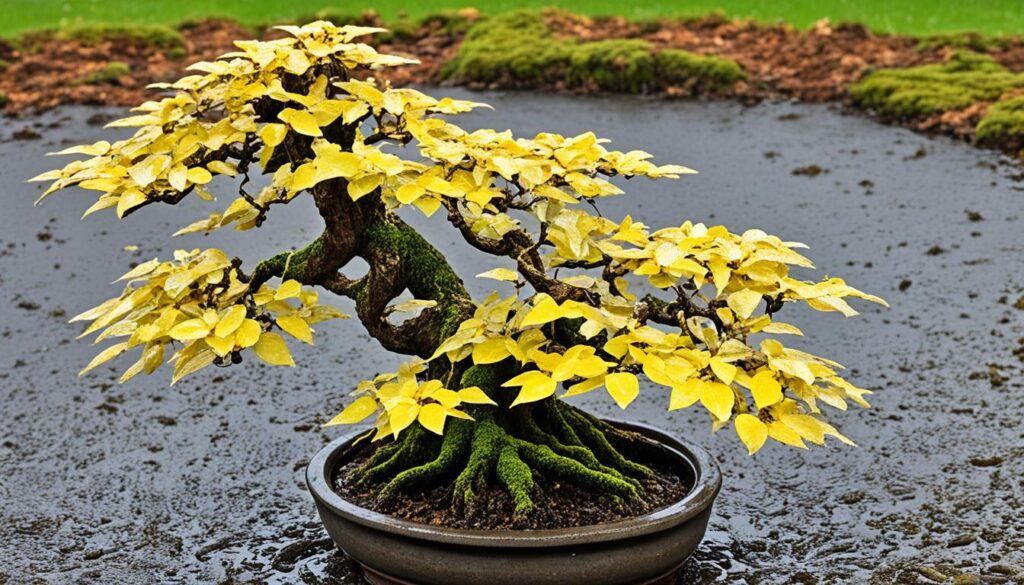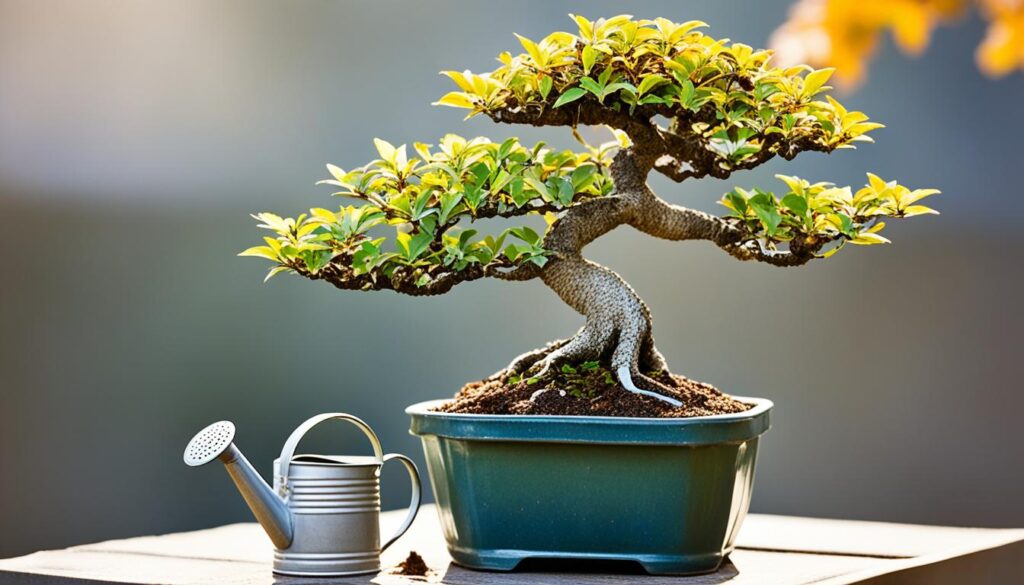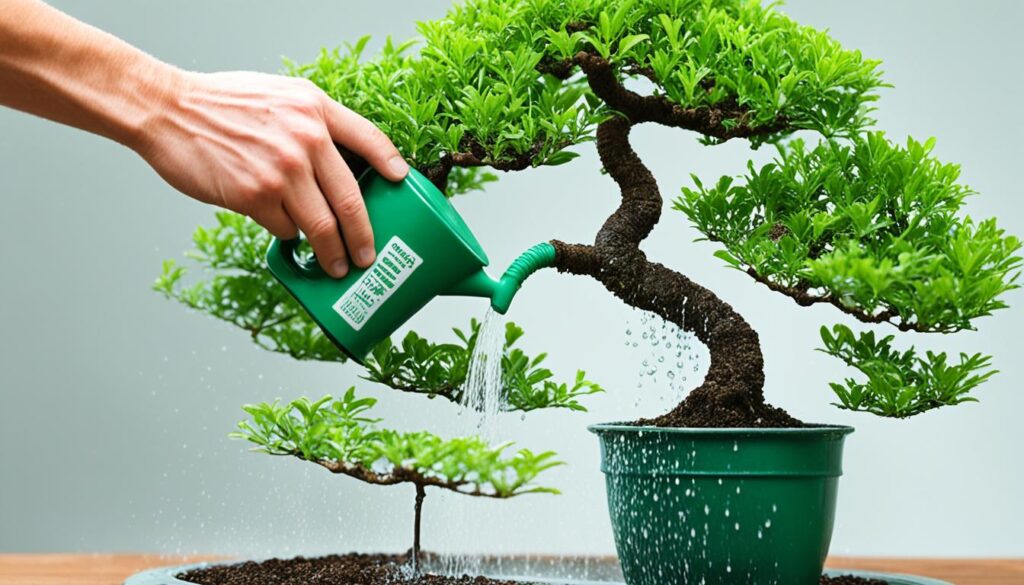Did you know a bonsai tree might need up to 6 gallons of water each week to look its best? It’s true! Proper watering is key for keeping these tiny trees healthy and alive. We’ll dive into the best watering schedule for your bonsai, considering things like the environment, the type of bonsai, and the soil it’s in. By knowing what your bonsai needs, you can help it flourish and enjoy it for many years.
Key Takeaways
- Bonsai trees need regular watering to keep their leaves from drying out and stay healthy.
- Smaller bonsai in shallow pots need more water than larger ones in deeper pots.
- Things like wind and sunlight can change how much water a bonsai needs.
- Think about the soil type and the risk of root rot when setting your watering schedule.
- Using the right watering methods, like soaking the soil and using rainwater, is important for bonsai care.
Environmental Factors That Affect Bonsai Watering
Keeping your bonsai tree healthy means paying attention to the environment. Wind, sunlight, and heat can change how much water your bonsai needs. It’s important to know these factors to water your bonsai right.
Wind and Its Impact on Watering Needs
Wind can dry out bonsai trees quickly because of their small roots and soil. So, they need more water when it’s windy. Keep an eye on the wind and water your bonsai more often to keep it healthy.
Sunlight and Heat: Their Role in Determining Water Requirements
Sunlight and high temperatures make bonsai trees lose water faster. They work hard to cool themselves, which means they lose more water. Watch how your bonsai reacts to the sun and heat to know when to water it.
Knowing how bonsai watering changes with the environment helps you care for your bonsai better. Keep an eye on your bonsai and adjust your watering to keep it looking great.
“Proper watering is one of the most critical aspects of bonsai care, and it requires attentiveness to the plant’s needs and environmental conditions.”
Bonsai Species and Their Watering Preferences
Understanding the watering needs of different bonsai species is key to caring for your bonsai tree. The amount of water your bonsai needs can change a lot based on its natural habits and traits. Knowing the bonsai species watering requirements helps you give your plant the right amount of water to stay healthy.
Deciduous bonsai trees need more water because their big leaves lose a lot of moisture. This means they need more bonsai tree water needs to stay healthy. Coniferous bonsai trees, with their small needles, lose less water and need less bonsai plant hydration.
Tropical bonsai trees, used to warm and humid places, need less water than trees from cooler climates. They don’t need as much deciduous bonsai watering as trees from temperate areas.
It’s important to check the soil moisture and look for signs of too little or too much water. This helps you know how much coniferous bonsai watering your bonsai needs. By understanding what your bonsai likes, you can give it the right amount of tropical bonsai watering to keep it healthy.
“The key to successful bonsai care is understanding the specific watering needs of your tree’s species.”

Getting the watering right is crucial for your bonsai’s health and growth. By adjusting your watering based on your bonsai’s species, you make sure it gets the right amount of water to flourish.
Identifying When Your Bonsai Needs Water
Knowing when your bonsai tree needs water is key to its health. Check the soil moisture and the moss on top to set the right watering schedule. This helps keep your bonsai happy and healthy.
Monitoring Soil Moisture Levels
Checking the soil moisture is a great way to see if your bonsai needs water. You can do this by touching the soil or using a moisture meter. If the top inch of soil feels dry, it’s time to water your bonsai. A moisture meter gives a precise reading, showing levels from 1 (dry) to 10 (wet).
Observing Moss and Its Relationship to Watering
Moss on your bonsai’s soil can tell you a lot about watering needs. Healthy moss means the soil is moist, and your bonsai is hydrated. If the moss looks dry or is dying, your bonsai needs water.
Using these methods together helps you understand your bonsai’s bonsai water needs identification. This way, you can give your tree the bonsai soil moisture monitoring and bonsai water requirement signs it needs to flourish.
“The key to successful bonsai care is to listen to the plant and respond to its individual needs. By closely observing the soil and moss, you can become attuned to your bonsai’s bonsai moss watering indicator and ensure its optimal health.”
Signs of Overwatering Your Bonsai Tree
Overwatering can harm a bonsai tree as much as underwatering. It’s key to know the signs of overwatering to keep your bonsai healthy. Look out for yellowing or wilting leaves, fungal growth, and root rot.
Yellowing or browning leaves are a big clue that your bonsai is overwatered. This happens when roots get too much water and can’t breathe. You might also smell a sour, musty smell in the soil, which means root rot is setting in.
- Yellowing or wilting leaves
- Fungal growth on the soil or tree
- Root rot, indicated by a sour, musty odor in the soil
- Slow growth or stunted development of the bonsai
Too much water can bring harmful germs and bacteria. These can cause fungal infections and slow down your bonsai’s growth. You might see spots on the leaves or the tree just won’t grow well.
“Overwatering a bonsai tree can lead to root rot, affecting the tree’s longevity.”
To stop overwatering, watch the soil moisture closely and adjust your watering. Choosing the right soil, making sure it drains well, and watering based on the environment can help. These steps can keep your bonsai tree healthy for a long time.

Signs of Underwatering Your Bonsai Tree
Keeping the right amount of water is key for your bonsai tree’s health. Underwatering can be as bad as overwatering. It’s vital for bonsai lovers to spot underwatering signs early to fix them quickly.
Wilting and Drooping Leaves
Wilting or drooping leaves often mean your bonsai is thirsty. Without enough water, leaves lose their shape and color. This is the tree’s way of saying it needs water fast.
Yellowing or Browning of Foliage
Yellow or brown leaves also signal underwatering. The plant can’t keep enough moisture, causing color changes. In worse cases, leaves may drop off to save water.
Spotting bonsai dehydration symptoms and bonsai wilting leaves early is key. Fixing bonsai leaf discoloration and bonsai slow growth from underwatering quickly helps your bonsai stay healthy.
“The key to healthy bonsai is finding the right balance between water, light, and nutrients. Underwatering can be just as detrimental as overwatering, so it’s important to pay close attention to the signs and adjust your watering routine accordingly.”
Container Size and Its Impact on Watering Frequency
The size of the bonsai’s container is key to its watering needs. Smaller pots dry out faster, needing more water than larger ones. It’s important to match the container size with the bonsai species and its roots for the right watering schedule.
Most indoor bonsai need water every 2-3 days. But, this can change based on the bonsai type, pot size, and the environment. Always check the soil moisture and adjust watering to prevent too much or too little water.
Some bonsai like Ficus, Chinese Elm, and Azalea need more water often. Others, such as Portulacaria afra (elephant bush) and the Jade plant, can go longer between waters. Knowing what your bonsai needs is crucial for proper care.

The type of soil affects how often you need to water. Soils like akadama, pumice, and lava rock dry out quickly. On the other hand, compost and peat moss hold moisture longer. Temperature, humidity, and sunlight also play a part in your bonsai’s watering needs.
Bigger bonsai in larger pots can hold more water, lasting longer between waters. But, small pots need more frequent watering to keep the soil moist and prevent stress.
Understanding how container size affects watering helps you create a schedule that’s right for your bonsai. This ensures your tree stays healthy and thrives over time.
Soil Composition and Its Effect on Bonsai Watering
The type of soil your bonsai tree uses is key to how much water it needs. Soils with akadama, pumice, and lava rock are great because they let water drain well but still keep enough moisture for the roots. On the other hand, using regular compost can make the soil too wet, causing root rot and other issues.
Importance of Well-Draining Soil Mixes
Bonsai trees need soil that holds some water, drains well, and lets air in. Soils with pine bark absorb water well but break down, reducing drainage. Soils like volcanic lava, calcite, and baked clays drain and aerate well but need careful fertilizer use because they don’t absorb nutrients as much.
Avoiding General-Purpose Compost for Bonsai Plants
Don’t use regular compost for bonsai because it holds too much water, causing bonsai compost watering issues and root rot. Instead, choose a bonsai well-draining soil mix with akadama, pumice, and lava rock. This ensures your bonsai gets the right amount of water for its health.
“Over the past 10 years, I’ve learned through trial and error about properly watering bonsai trees, and I’ve killed more than a handful of trees due to incorrect watering methods.”
The soil type for your bonsai greatly affects its health and how it holds water. Knowing the importance of well-draining soil and avoiding regular compost helps your bonsai get the right water amount to flourish.
Proper Watering Techniques for Bonsai Trees
Keeping your bonsai tree’s water balance is key to its health and life. The right way to water is to soak the roots fully until water drains from the container’s bottom. This makes sure all roots get enough moisture.
Soaking the Entire Root System
Bonsai trees have small root systems and can suffer from too much or too little water. To prevent this, water your bonsai well, letting the soil get soaked. Pour water slowly until it drains from the container’s bottom. This method makes sure the roots get the water they need to stay healthy.
Using Rainwater vs. Tap Water
Using rainwater is better for your bonsai tree when you can. Rainwater lacks the chemicals found in tap water, like chlorine and fluoride. These chemicals can harm your bonsai’s roots over time. Rainwater gives your tree a more natural and better water source, helping it stay healthy.
Proper bonsai watering means watching the soil moisture and adjusting as needed. Keep an eye on your bonsai and the soil to find the best watering schedule for your tree.

“Watering your bonsai tree is an art form in itself, requiring a delicate touch and keen observation to ensure your tree receives the perfect balance of moisture it needs.”
how often should i water my bonsai tree
Watering your bonsai tree is a delicate task. The right frequency depends on many factors. Generally, you should water your bonsai every 2-4 days. This depends on the tree type, pot size, and whether it’s indoors or outside. The season also plays a role.
Overwatering is a big problem, causing about 60-70% of bonsai tree deaths. Underwatering is also bad, leading to around 20-30% of deaths. It’s crucial to keep the soil’s moisture level between 50-70% for most bonsai trees.
In hot and dry places, bonsai trees might need more water, even up to once a day. Adjust your watering based on your bonsai’s specific needs, not just a set schedule. Checking the soil and looking at your tree can help you find the best watering schedule.
The right watering frequency for your bonsai tree varies. By watching your plant and adjusting your watering, you can keep your bonsai healthy and beautiful.
Bonsai Watering Tips and Common Mistakes
Keeping the right bonsai watering schedule is key for your tree’s health. But, many bonsai lovers make a big mistake. They stick to a set watering plan without thinking about each bonsai’s needs. It’s important to watch and adjust the bonsai watering based on different factors.
Avoiding Watering on a Strict Schedule
Bonsai trees need different amounts of water because of their type, pot size, soil, and where they live. If you water your bonsai the same way every time, you might give it too much or too little water. This can hurt the plant. By being flexible and watching what your bonsai needs, you can keep it properly watered and avoid mistakes.
Adjusting Watering Based on Environmental Conditions
How much water your bonsai needs changes with the weather like temperature, humidity, and sunlight. In hot, dry, or windy weather, your bonsai might need more water to stay moist. But in cooler, cloudy, or rainy weather, it might need less. By checking the soil and changing the bonsai watering schedule as needed, you can give your plant the right amount of water.

“The key to successful bonsai watering is adaptability, not rigidity. Pay attention to the unique needs of your bonsai and adjust your watering practices accordingly.”
Rain and Its Impact on Bonsai Watering Needs
As a bonsai enthusiast, you might see rain as both a help and a challenge for your watering routine. Bonsai rain watering is key, as rain can greatly affect how much water your tree needs.
In wet climates or during rainy seasons, your bonsai might need less water from you. The bonsai rain impact watering can keep the tree hydrated, making you water it less often. But, watch out for bonsai overwatering from rain and the need for bonsai wet weather watering.
Too much rain can cause overwatering, especially for bonsai with weak roots. To keep your bonsai healthy, check the soil moisture often and adjust watering as needed. You might need to water less or stop watering during heavy rain.
“Proper watering is essential for the health and longevity of your bonsai tree. Finding the right balance between natural precipitation and manual watering is key to keeping your bonsai thriving.”
By watching and changing your watering based on bonsai rain watering conditions, you can make sure your bonsai gets the right moisture. The aim is to give your bonsai the best hydration for growth and health.
Like all bonsai care, it’s key to watch your tree’s specific needs and adjust as needed. Understanding how rain affects your bonsai’s watering needs helps you make a watering plan that keeps your tree healthy and strong.
Pot-Bound Bonsai Trees and Watering Requirements
Bonsai trees can become pot-bound or root-bound as they grow. This means their roots fill the pot, leaving little room for soil. These bonsai container-bound or bonsai restricted root system trees need special care when it comes to watering.
One big challenge with watering these bonsai is the small amount of soil. Because of this, they dry out faster than trees with more space. This is because there’s less soil to hold moisture.
- To help these bonsai, you might need to water them more often.
- Always check the soil moisture and water your bonsai more, especially when it’s hot or dry.
Adjusting how you water is also important for bonsai with limited space. Make sure to soak the roots well. This is hard because the soil is so small, and water can’t easily reach all the roots.
“Maintaining the delicate balance of moisture for a pot-bound bonsai is crucial for its long-term health and vitality.”
By understanding the special watering needs of bonsai in small pots, you can keep your bonsai healthy. This way, your bonsai can flourish even with a small root system.

Seasonal Changes and Their Effect on Watering
As seasons change, your bonsai tree’s water needs change too. It’s important to know these changes to keep your bonsai healthy and alive.
In the active growing season, which is usually in spring and summer, your bonsai needs more water. This is because it grows more and uses more water. The warm weather and long days make the soil dry out faster, so you’ll need to water your bonsai more often.
But in the dormant winter months, your bonsai uses less water. You should water it less to prevent root rot.
Watering your bonsai in fall and spring is also key. In fall, you’ll water less to help your bonsai get ready for the cold. In spring, you’ll water more to help it grow and develop.
“Adapting your watering practices to the changing seasonal conditions is essential for the long-term health and vitality of your bonsai.”
By watching your bonsai’s water needs and changing your watering schedule, you can help your tree do well all year round.
Conclusion
Learning about the factors that affect a bonsai’s water needs helps you create a watering plan. This plan keeps your miniature tree healthy and growing well. The guide has given you the knowledge to be a great bonsai caretaker.
It’s important to be flexible, watch closely, and understand your trees’ unique needs. This is the secret to successful bonsai watering.
If you love bonsai or are just starting, learning how to water them is key. This guide has given you the tips to become a bonsai watering expert. You’ll keep your trees looking great.
Knowing what affects your bonsai’s water needs lets you tailor your watering. This ensures your trees stay healthy and full of life. Enjoy caring for your bonsai and let your love for these plants lead you to a fulfilling bonsai experience.


